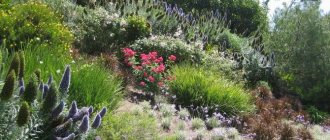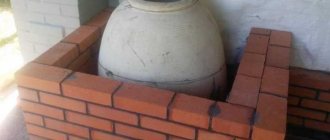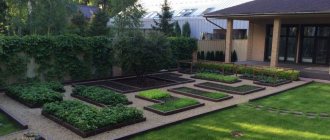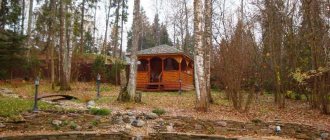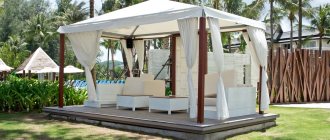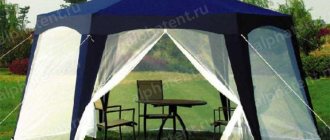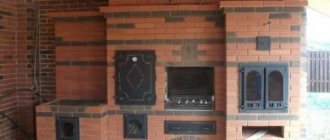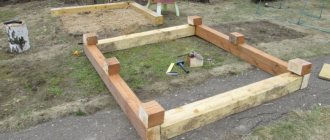A comfortable and cozy gazebo at the dacha will become a favorite place for family or friendly pastimes; you can install it at a dacha in a permanent place or make it in a collapsible version, otherwise known as a tent. It is not inferior either in comfort or in external qualities to a structure made of wood and has visible advantages. In this article we will look at how to make a tent with your own hands.
Structure and functions of the tent
A tent is in many ways more convenient than a permanent structure. Let's look at the advantages and disadvantages of such a building.
Advantages and disadvantages of the design
A tent is a temporary structure. It is ideal if you need to move from place to place or construction is needed only for the summer.
A prefabricated structure consisting of a frame, most often metal, and a waterproof fabric.
IMPORTANT! The tents are very comfortable, do not require a lot of effort and money during construction, and are easy to install in the summer.
The cost of a tent is significantly less than building a wooden gazebo, even if you build it yourself. Many tents require self-assembly, so even one person can assemble it without the help of specialists.
This structure can be moved to any place, disassembled and reassembled. Also, such a gazebo can be stored indoors in winter when assembled.
The tent can be used for picnics, outdoor recreation, or used as a place for children to play.
However, it is not comparable in strength to a gazebo, so during installation it is necessary to use additional fasteners for structural strength. The tarpaulin becomes unusable over time, so you will have to replace both the awning and the walls.
Existing types
Today, manufacturers offer different options for making tents and awnings. The most popular models are 2x2 meter tents. They have a very simple design and compact size. The fabric base is made of materials that do not allow moisture to pass through and can withstand wind loads well. If there is a need to organize a spacious space in the garden to receive a large number of guests, it is worth taking a closer look at models that look not like a tent, but like a full-fledged gazebo. Typically, such structures are easily disassembled and assembled; they are necessarily additionally decorated with some decorative elements.
Experts call rotundas a real work of art. This collapsible gazebo has a round or semicircular shape; it looks like a small building with a dome. Such an acquisition becomes justified when there is a need to make the tent the central decoration of the garden.
Large rotunda tents for events Source kramars.ru
Variety of designs
Tents come in different shapes and designs, but mostly they are either closed or open buildings.
Which is better - closed or open design
In this case, everything depends on the period of operation of the building. If it is summer time and the tent will be assembled for the cold season, then an open building is ideal. The closed type can be used in the fall, but in winter it will be cool. There are two types of mobile buildings: open and closed. The simplest model of a tent is a dome on four supports; this option can be used in both autumn and summer.
IMPORTANT! An open type of gazebo is installed near a barbecue or a private house; this type of construction serves as an additional decoration for a personal plot.
An awning with closed walls is simply irreplaceable in extreme heat or rain. If you use a mosquito net, you can also save yourself from insects. Moreover, for air circulation, you can open one of the walls.
Gazebo tent
A very common design. In specialized stores it is very easy to choose a beautiful awning for a gazebo. It is practical and functional. Its main difference from a simple folding tent is the presence of walls.
How many walls to install is up to each owner to decide for himself. The gazebo tent can easily be transformed into a small house. Its thick walls will reliably protect you from bad weather.
Recommendations for choosing materials for the frame and awning
For successful construction, you need to know the theory in order to successfully apply it in practice.
What materials to use for an awning, tent and light gazebo
The basis of any tent is the frame; its reliability and stability depends on the materials. Various materials are used, it all depends on the type of construction:
- tree;
- galvanized profile;
- brick;
- metal tubes;
- polypropylene.
IMPORTANT! For a comfortable stay, it is necessary to use mosquito nets, durable fasteners and fire-resistant awnings.
The following materials can be used for the awning:
- polyester;
- tarpaulin;
- acrylic;
- nylon.
IMPORTANT! It is better to make the side walls from natural fabrics such as linen, cotton or chintz.
Main characteristics
Let's consider a number of characteristics of summer cottage tents, which will become the basis for choosing a particular model.
Support material
Tents can be made of wooden, plastic or forged frames, each of which has its own nuances.
Metal
Advantages:
- long-term operation;
- no need for winter storage;
- copes well with precipitation and high humidity;
- gives reliability and support to the entire structure.
Flaws:
- the bulkiness and complete stationary nature of the structure, which requires the help of special equipment to move.
Tree
Advantages:
- aesthetic design;
- long-term operation;
- strength and stability of the entire structure;
- possibility of design variations.
Flaws:
- needs treatment from parasites and excess moisture;
- relatively high cost.
Plastic
Advantages:
- easily disassembled and moved to any place on the site;
- Suitable for small semi-enclosed areas.
Flaws:
- loses shape during prolonged use;
- does not hold up in strong winds;
- unable to hold a mass of dense tissue;
- requires special winter storage conditions.
You can also make wooden country tents yourself.
This does not require special knowledge or skill. It is enough to purchase a cut, draw a drawing and connect the structure together. A plastic support is more of an economical option for summer residents who don’t want to bother, but want to relax in the fresh air in comfort. If you do not plan to use the tent in autumn, winter and spring, then a plastic marquee tent is your option.
Forged supports are the pinnacle of design projects. Using various metals, you can not only decorate the racks, but also decorate any boring exterior of a country house. The metal will last a long time and does not require disassembly or special storage.
Fabric quality of tension material
The tent involves a frame base on which protective fabric is attached. Taking into account the characteristics of this material, you can choose cheaper and more expensive options, which is also determined by the level of strength, reliability and quality.
| Material | Advantages | Flaws |
| Mosquito net and thick fabric |
|
|
| Tarpaulin and raincoat fabric |
|
|
Lightweight options with airy fabric such as tulle are used for simple country gazebos, where there is a need to hide from the hot sun. Tarpaulin tents are more often found among tourists who travel through wild nature and are forced to adapt to weather conditions.
Features of the frame shape
The shape of a country tent is actually limited only by your imagination. You can build a tall structure, or get by with a more primitive one. Order exquisite fabrics, or take what is available. It all depends only on personal desires and financial capabilities.
As for the shape of the frame, it should be as simple, convenient and reliable as possible.
| Form | Advantages | Flaws |
| Rectangular elongated house |
|
|
| Square tent without roof |
|
|
| Hemisphere |
|
|
The simplest, according to experts, is a single frame for a tent. The roof and side walls are formed from the material.
Preparing the foundation for the construction of a tent at the dacha
It is easy to build a holiday tent with your own hands, but it requires special preparation and technical knowledge. In general, the construction does not require much physical effort or financial investment, but it pleases with its mobility and aesthetic appearance.
Features of territory preparation
The building should fit organically into the site. There should be flowers, a lawn, a pond, a lake or just a picturesque view nearby.
The surface under the tent must be cleared of stones and leveled.
If the building is being installed for a long time, then you need to pour a strip foundation and make the flooring from wood or stone.
For a temporary structure, it is enough to simply level the surface of the summer cottage and remove about 20 cm of soil, cover it with 15 cm of sand and compact it thoroughly.
Waterproof fabric
Moisture-resistant and waterproof tents are used in areas where there are frequent changes in climatic and weather conditions.
Such models help to completely protect a certain area of land from rain and retain the properties of protecting the covered area from the scorching sun, and protect people from insects and parasites.
How and with what to secure the tent on different surfaces
To ensure the strength of the building, additional fastenings should be installed.
Options for mounting a tent in the ground and on asphalt
When installing the structure on the ground, it is necessary to use safety guy wires. This way the building will last longer. The guy ropes consist of pegs 20 cm long and are driven in around the perimeter of the tent.
When installing a building in asphalt, it is necessary to use metal rods. They are inserted into special holes and filled with concrete.
Tent rating
To assess the quality of each model, many tests had to be carried out. First of all, we paid attention to the strength of the fabric, the degree of protection from the sun and rain, and the weight of the structure. When comparing the nominees to each other, we also took into account the following criteria:
- Shape – square, conical, rounded;
- Availability of mosquito net;
- Suitable scope of application;
- Additional equipment included;
- Wind resistance;
- Seam quality;
- Price.
Customer reviews, as well as independent expert assessments, helped us make the rating more objective.
Decoration options
After completing the construction of the tent, it is worth treating it with colored or natural varnish. The awning can be sewn from fabric of cheerful and bright colors, and the fasteners and Velcro of the mosquito net will serve as additional decor.
Place wicker furniture inside the room, hang light, flowing curtains; if there is electricity, then bedside lamps or floor lamps look very nice. Also, cute vases, pots and figurines will add atmosphere and comfort to the room.
A tent is a very comfortable and lightweight structure that makes outdoor recreation unforgettable. You can comfortably sit here for the whole family and enjoy breakfast or lunch at a large table, enjoying the contemplation of nature and breathing fresh air.
What are big tents made of?
The time of the appearance of the tents does not belong to either the current or the previous century. The existence of tent structures dates back about a thousand years. They were a reliable refuge not only for nomadic peoples, but also for those who went on long campaigns: merchants, warriors, travelers.
In those distant times, animal skins were most often used to make tents, and some craftsmen did it very skillfully.
Nowadays, large tents are practically not used for permanent residence, but, nevertheless, these architectural forms are often used in everyday activities. Only a few can say that they have never spent the night in a tent or hid from the rain in a tent or under an awning.
The frame for large tents is made of fiberglass, aluminum or carbon. Each of these materials has its own advantages. One material is of high quality, the other has a favorable price. Carbon is considered the highest quality and most expensive material. However, fiberglass and aluminum also cope well with the task assigned to them.
The stability and reliability of large tent structures also depends on the fastenings that are used to assemble the frame. According to consumer observations, a simple rule works here: the more famous the manufacturer, the better the quality of the fastenings.
- Fabrics
Manufacturers use nylon and polyester to make large tents. Nylon is a lighter option and at first, when making large tents, the emphasis was on it, but as it turned out, this fabric is not very resistant to UV radiation and deforms when wet. Therefore, the bottom of the temporary shelter is most often made from nylon, and the top from polyester.
- Anti-wetting treatment
To prevent the fabric from allowing water to pass through, it is treated with silicone or polyurethane. Polyurethane is heavier and is used to cover the fabric on the inside. Silicone is an order of magnitude lighter; it penetrates into the material, completely enveloping each fiber.
